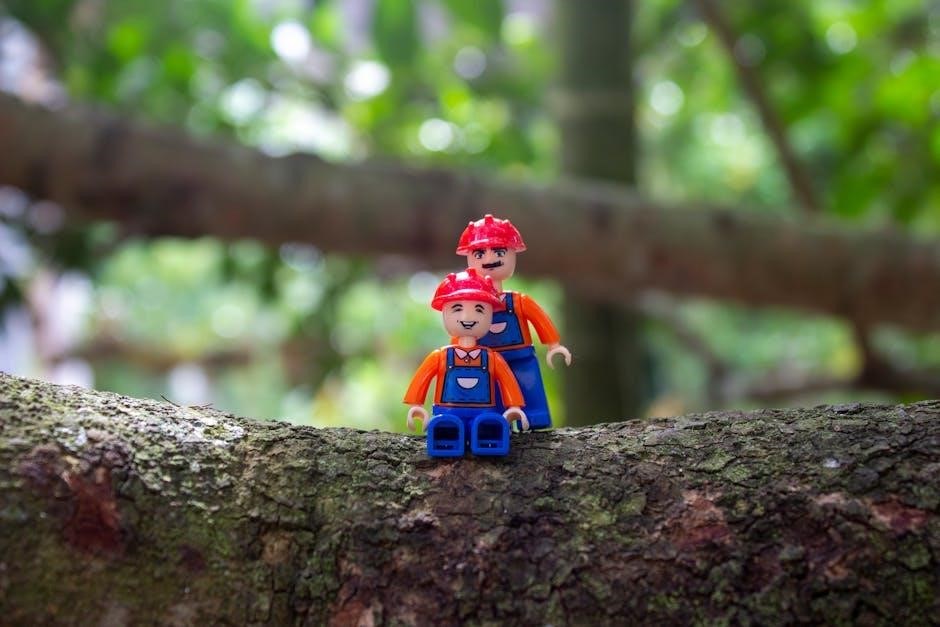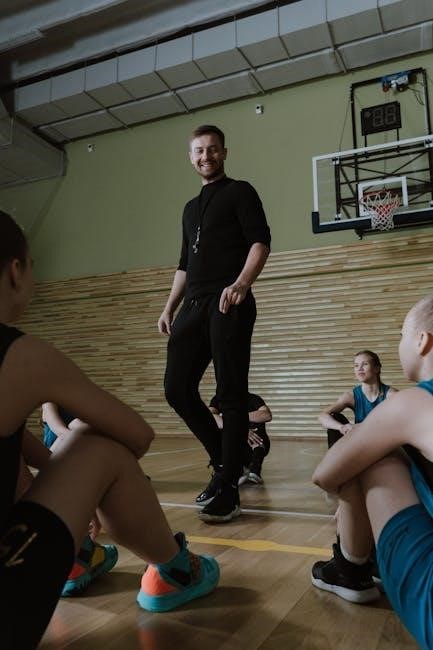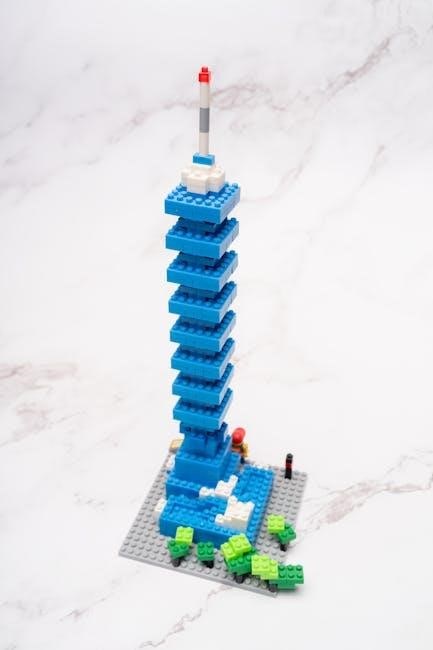FIRST LEGO League building instructions provide a structured guide for teams to design and assemble innovative robots using LEGO bricks and components. These instructions help participants aged 4-16 develop essential STEM skills through hands-on, project-based learning. By following step-by-step plans, young engineers can create functional robots that solve real-world challenges, fostering creativity, problem-solving, and teamwork. The instructions are tailored to different skill levels, ensuring accessibility for beginners while challenging advanced builders to innovate and optimize their designs. This foundational aspect of FLL prepares students for future STEM careers and lifelong learning.
What is FIRST LEGO League?
FIRST LEGO League (FLL) is an international robotics program designed for children aged 4-16, fostering STEM education through hands-on learning. It combines LEGO bricks with real-world challenges, encouraging creativity and problem-solving. Participants design, build, and program robots to solve missions, developing engineering and coding skills. FLL is organized by FIRST and LEGO, aiming to inspire young minds in science, technology, and innovation. The program is divided into age-specific divisions: Discover for 4-6 year olds, Explore for 6-9 year olds, and Challenge for 9-16 year olds, ensuring tailored learning experiences for all participants.
The Importance of Building Instructions in FLL
Building instructions are a cornerstone of FIRST LEGO League, guiding teams through the assembly of robots and mechanical systems. These step-by-step guides help participants understand engineering principles, programming, and problem-solving. By following instructions, young builders develop essential STEM skills, such as critical thinking and hand-eye coordination. The structured approach ensures that even complex designs are accessible, fostering confidence and creativity. Instructions also promote teamwork, as members collaborate to interpret and execute plans. They serve as a foundation for innovation, enabling teams to customize and refine their creations for optimal performance in competitions. This hands-on learning enhances technical proficiency and prepares students for future challenges in science and technology.

History and Evolution of FIRST LEGO League
FIRST LEGO League emerged in the mid-90s as a merger between FIRST and LEGO, aiming to inspire young minds in STEM through robotics and creativity. The program has since grown globally, evolving to address real-world challenges and foster innovation.
Origins of the Program
The FIRST LEGO League (FLL) was created through a partnership between FIRST and the LEGO Group in the mid-1990s. It was designed to engage children in STEM education by combining LEGO bricks with robotics and real-world challenges. The program aimed to foster creativity, critical thinking, and teamwork among youth. Initially targeting ages 9-14, it later expanded to include younger participants through programs like Discover and Explore. The origins of FLL lie in its mission to inspire the next generation of innovators by making learning fun and accessible through hands-on, project-based experiences.
Key Milestones in FLL Development
FLL was officially launched in 1998, marking the beginning of its global impact. The program rapidly expanded, introducing themed challenges annually to address real-world issues. In 2014, the “World Class” challenge engaged over 265,000 participants from 80 countries. The program evolved to include age-specific divisions: Discover for ages 4-6, Explore for ages 6-9, and Challenge for ages 9-16. This expansion ensured inclusivity and catered to varying skill levels. FLL has consistently updated its curriculum to align with modern STEM trends, fostering innovation and inspiring future leaders in technology and engineering;

Core Components of FIRST LEGO League
FIRST LEGO League combines robotics kits, LEGO bricks, and programming tools, fostering teamwork and hands-on STEM learning across age-specific divisions, encouraging creativity and problem-solving.
Robotics Kits and LEGO Bricks
Robotics kits and LEGO bricks are central to FIRST LEGO League, enabling participants to build and program functional robots. These kits provide pre-designed components, such as motors and sensors, which students combine with LEGO bricks to create custom robots. The LEGO brick system offers endless design possibilities, encouraging creativity and problem-solving. By integrating these tools, young engineers learn mechanical and programming principles, preparing them for STEM careers. The kits are designed for various age groups, ensuring accessibility and progression. They also foster teamwork, as students collaborate to design, build, and optimize their robots for competition challenges.
Programming and Software Tools
FIRST LEGO League utilizes programming tools like LEGO Mindstorms EV3 and Scratch, enabling teams to bring their robots to life. These software tools allow students to design and implement algorithms, controlling robot movements and interactions. Programming concepts are introduced in an accessible way, suitable for various skill levels. Teams learn to code sensors, motors, and logic sequences, fostering problem-solving and critical thinking. The software tools empower young engineers to test, iterate, and refine their programs, preparing them for real-world STEM challenges and future careers in technology and innovation. This hands-on approach makes complex programming concepts engaging and attainable for participants.
Teamwork and Collaboration
Teamwork is a cornerstone of FIRST LEGO League, as students work together to design, build, and program their robots. Collaboration fosters creativity, problem-solving, and mutual respect among team members. Each participant contributes unique skills, whether in building, coding, or strategy. Coaches and mentors guide teams, encouraging open communication and shared goals. Through teamwork, students learn to navigate challenges, adapt to feedback, and celebrate successes. This collaborative environment prepares them for real-world STEM careers, emphasizing the value of diverse perspectives and collective effort. Teamwork in FLL builds lifelong skills in leadership, empathy, and cooperation, shaping well-rounded individuals.

The Annual FLL Challenge
FIRST LEGO League releases a new Challenge annually, focusing on real-world scientific themes. Teams design and build robots to solve missions, fostering hands-on STEM learning for ages 4-16.
Themed Challenges and Missions
Each season, FIRST LEGO League introduces a new theme, such as World Class or Animal Allies, inspiring teams to solve real-world problems through robotics. Missions are designed to challenge participants, requiring innovative robot designs and programming solutions. Teams must complete tasks within a competitive field, fostering creativity and critical thinking. These themed challenges not only align with STEM education but also encourage collaboration and problem-solving skills. By addressing global issues, FLL prepares young minds to tackle future challenges while making learning fun and engaging. The missions are a cornerstone of the competition, driving innovation and inspiring the next generation of engineers and scientists.
Rules and Scoring System
FIRST LEGO League competitions follow a structured set of rules to ensure fair play and consistency. Teams of students aged 9-16 (varies by region) compete by programming and controlling their robots to complete themed missions on a playing field. Scoring is based on the number and complexity of missions accomplished, with bonus points for innovative designs. Judges also evaluate teamwork, problem-solving, and adherence to Core Values, such as gracious professionalism and collaboration. Penalties may apply for rule violations, ensuring sportsmanship and fair competition. This system encourages precision, creativity, and strategic thinking while fostering a positive, competitive environment.

Step-by-Step Building Instructions for FLL Robots
FLL provides detailed guides for assembling robots using LEGO kits, tailored for 9-16-year-olds. Instructions cover basic builds, advanced techniques, and customization to prepare for competitions and develop engineering skills;
Basic Robot Design and Assembly
Basic robot design and assembly in FLL focuses on creating a sturdy, functional foundation using LEGO bricks and motors. Teams learn to build simple yet effective robots capable of performing tasks. Instructions guide participants through selecting the right components, assembling chassis, and integrating sensors. Emphasis is placed on stability, mobility, and ease of control. These foundational skills help teams progress to more complex designs and prepare them for competition challenges; The process fosters problem-solving and collaboration, essential for success in FIRST LEGO League events.
Advanced Building Techniques
Advanced building techniques in FLL involve complex mechanisms, such as gear systems, pneumatics, and sensor integration, to enhance robot functionality. Teams learn to optimize designs for precision and efficiency, incorporating lightweight yet durable structures. These methods often require iterative prototyping and testing to refine performance. Techniques like modular design and compact builds allow for adaptability in competition settings. By mastering these skills, participants can create robots capable of performing intricate tasks with high accuracy. Advanced techniques also emphasize programming integration, ensuring seamless control of mechanical components. This level of expertise prepares teams for the challenges of high-level competitions and real-world engineering scenarios.
Customizing and Optimizing Your Robot
Customizing and optimizing your FLL robot involves tailoring its design to meet specific mission requirements while enhancing performance. Teams can modify attachments, add sensors, or adjust mechanisms to improve functionality. Iterative testing and refinement are crucial, as small changes can significantly impact efficiency. Weight distribution, gear ratios, and motor placement are often fine-tuned for optimal results. Customization also allows teams to address unique challenges in each competition season. By balancing creativity with practicality, participants can create robots that excel in diverse tasks, showcasing their problem-solving skills and innovative thinking. This process fosters a deeper understanding of engineering principles and design iteration.

Resources for Learning FLL Building Instructions
Official FLL guides, online forums, and community workshops provide valuable resources for mastering robot building. These tools offer step-by-step tutorials, expert tips, and hands-on training opportunities.
Official FLL Guides and Tutorials
Official FLL guides and tutorials are comprehensive resources designed to help participants master the art of robot building. These materials, developed by FLL experts, cover fundamental concepts such as robot design, assembly, and programming. They include step-by-step instructions, visual diagrams, and real-world examples to ensure a smooth learning curve. Tutorials often focus on specific skills like gear systems, motor efficiency, and sensor integration. Additionally, official guides provide tips for optimizing robot performance and preparing for competitions. They are available in multiple formats, including downloadable PDFs and video tutorials, making them accessible to teams worldwide. These resources are essential for both novice and advanced builders aiming to enhance their FLL experience.
Online Communities and Forums
Online communities and forums dedicated to FIRST LEGO League provide invaluable support for teams and individuals seeking guidance on building instructions. Platforms like Reddit, Facebook groups, and specialized FLL forums foster collaboration, allowing members to share tips, ask questions, and showcase their creations. Experienced mentors and veteran teams often contribute, offering expert advice and troubleshooting common issues. These spaces are particularly useful for newcomers, providing access to resources, tutorials, and build guides. Engaging with these communities not only enhances technical skills but also encourages creativity and perseverance, helping teams refine their robots and prepare for competitions effectively. Active participation can significantly improve building outcomes and overall FLL success.
Workshops and Training Programs
Workshops and training programs play a crucial role in enhancing FIRST LEGO League building skills. These structured sessions offer hands-on experience, guiding participants through robot assembly, programming, and advanced techniques. Led by experienced coaches or mentors, workshops often cover specific challenges, such as mission design or mechanical engineering. They provide a collaborative environment where teams can practice, iterate, and refine their builds. Many programs include interactive demonstrations, troubleshooting sessions, and tips for optimizing robot performance. By attending these events, teams gain confidence, improve their technical abilities, and develop strategies to excel in FLL competitions. Workshops are an invaluable resource for both novice and experienced builders.

Tips for Successful FLL Building
Understanding competition requirements, practicing design iterations, and troubleshooting common issues are key to successful FLL building. These strategies ensure well-designed, functional robots that meet challenge demands effectively.
Understanding the Competition Requirements
Understanding the competition requirements is crucial for success in FIRST LEGO League. Each season introduces a unique theme with specific missions and rules. Teams must familiarize themselves with the challenge manual to grasp scoring systems, robot constraints, and field layouts. Participants aged 4-16 engage in age-appropriate programs, from Discover to Challenge, ensuring skills are developed progressively. Adhering to rules ensures fair competition and focuses on innovation within guidelines. By thoroughly understanding these requirements, teams can design robots that meet objectives effectively, fostering strategic thinking and teamwork to achieve optimal results and empower young innovators. This knowledge is foundational for competitive success.
Practicing and Iterating Designs
Practicing and iterating designs is a cornerstone of FIRST LEGO League success. Teams repeatedly test and refine their robots to ensure reliability and effectiveness. Through hands-on experimentation, participants identify design flaws and optimize their builds for better performance. This iterative process fosters problem-solving skills and perseverance. By tweaking mechanisms, improving programming, and enhancing efficiency, teams can achieve higher scores in competitions. Regular practice also strengthens collaboration, as members share insights and work together to overcome challenges. Iteration ensures that each design evolves into its best possible form, preparing teams for the demands of the annual FLL Challenge and beyond;
Troubleshooting Common Issues
Troubleshooting is essential for resolving common issues during robot construction and competition. Teams often encounter mechanical malfunctions, such as misaligned gears or unstable structures, which can be fixed by re-examining designs and ensuring proper alignment. Programming errors, like sensor misconfiguration or logic flaws, require careful code review and testing. Electrical issues, such as loose connections or power failures, can be addressed by inspecting wires and ensuring secure links. Time management during competitions is another challenge, as teams must quickly identify and fix problems. By systematically identifying root causes and implementing solutions, teams can enhance their robot’s performance and preparedness for challenges.

The Role of Coaches and Mentors
Coaches and mentors play a vital role in guiding FLL teams, fostering creativity, and helping members develop STEM skills through hands-on learning and problem-solving.
Guiding Teams in Building Robots
Coaches and mentors guide FLL teams through robot construction, emphasizing teamwork and problem-solving. They help participants understand building instructions, troubleshoot designs, and optimize functionality. By fostering a collaborative environment, they ensure each member contributes to the robot’s development, aligning with competition requirements. Mentors also encourage creative solutions and adaptability, preparing teams for challenges. Their expertise and support are crucial in helping teams navigate complex tasks, ensuring a successful and educational experience in FIRST LEGO League robotics.
Encouraging Creativity and Problem-Solving
FLL building instructions inspire creativity by allowing teams to adapt and customize designs to meet mission challenges. Coaches encourage innovative thinking, enabling participants to transform basic concepts into unique solutions. Problem-solving is fostered through hands-on experimentation, where teams iteratively refine their robots to achieve optimal performance. These experiences introduce young engineers to core engineering principles, promoting critical thinking and adaptability. By balancing structured guidance with creative freedom, FLL empowers students to explore STEM concepts while developing essential skills for future innovations.

Impact of FLL on STEM Education
FLL fosters STEM skills in young minds through hands-on learning, inspiring creativity and problem-solving. It introduces fundamental concepts, preparing the next generation of innovators and engineers.
Developing Engineering and Coding Skills
FIRST LEGO League (FLL) empowers students to develop essential engineering and coding skills through hands-on experiences. By designing and programming robots, participants learn fundamental concepts like algorithm design, sequencing, and debugging. The use of LEGO bricks and programming tools such as Scratch or Python fosters creativity and problem-solving abilities. FLL’s structured approach encourages students to apply STEM principles to real-world challenges, enhancing their critical thinking and innovation skills. This iterative learning process prepares young minds for future careers in technology and engineering, while building confidence in their ability to tackle complex problems.
Encouraging Interest in Technology and Innovation
FIRST LEGO League fosters a passion for technology and innovation in young minds by engaging students in hands-on, project-based learning. Through building and programming robots, participants explore STEM concepts in a fun, interactive way. The program introduces children aged 4-16 to real-world challenges, inspiring them to think creatively and develop innovative solutions. By combining LEGO bricks with cutting-edge technology, FLL sparks curiosity and excitement, encouraging students to pursue careers in tech and engineering. The competitive yet collaborative environment motivates learners to embrace innovation and view technology as a tool for solving global problems, preparing them for future challenges with confidence and creativity.

Future of FIRST LEGO League
FIRST LEGO League continues to evolve, introducing new challenges and innovations. The program integrates advanced technology and LEGO bricks to inspire future engineers. Global participation grows, fostering a community of young innovators.
Upcoming Challenges and Innovations
FIRST LEGO League continues to innovate, introducing new challenges that align with real-world scientific themes. Future seasons will feature advanced robotics kits and AI integration, encouraging complex problem-solving. The program is expanding its global reach, engaging more diverse teams. New building instructions will incorporate sustainable materials and eco-friendly designs, reflecting a focus on environmental awareness. These updates aim to inspire the next generation of engineers and innovators, bridging the gap between LEGO brick assembly and real-world technological advancements. By staying relevant, FLL ensures its impact on STEM education remains strong, preparing students for future challenges.
Expanding Global Participation
FIRST LEGO League is actively expanding its global presence, engaging teams from diverse cultures and regions. The program has grown to include participants from over 100 countries, fostering a unified STEM community. By partnering with local organizations and translating materials, FLL ensures accessibility for all. New initiatives aim to reach underserved areas, breaking down barriers like language and resource limitations. This global expansion not only broadens opportunities for young innovators but also enriches the program with varied perspectives. As FLL continues to grow, it inspires a culturally rich and collaborative environment, preparing students worldwide for future challenges and fostering a love for STEM.

Be First to Comment